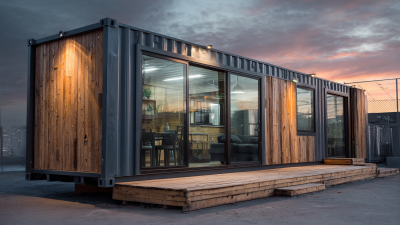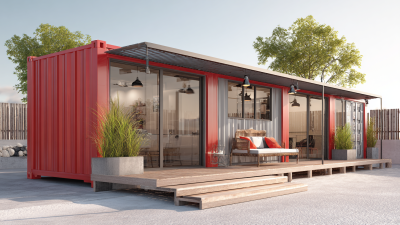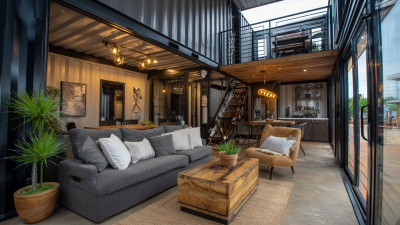 The rise of container homes has revolutionized the housing industry, providing an innovative and sustainable solution for modern living. According to a report by Research Nester, the global container homes market is projected to grow at a compound annual growth rate (CAGR) of 6.6% from 2021 to 2028, indicating a strong demand for eco-friendly housing options. This trend is driven by the increasing need for affordable housing, with container homes offering a cost-effective alternative to traditional construction methods. Additionally, the flexibility and versatility of container home designs allow homeowners to create unique living spaces tailored to their individual needs. With the potential to repurpose discarded shipping containers, this approach not only minimizes waste but also promotes sustainability in the construction sector. As you embark on the journey of designing your dream container home from scratch, it's essential to explore the myriad options available and understand the intricacies involved in this exciting architectural movement.
The rise of container homes has revolutionized the housing industry, providing an innovative and sustainable solution for modern living. According to a report by Research Nester, the global container homes market is projected to grow at a compound annual growth rate (CAGR) of 6.6% from 2021 to 2028, indicating a strong demand for eco-friendly housing options. This trend is driven by the increasing need for affordable housing, with container homes offering a cost-effective alternative to traditional construction methods. Additionally, the flexibility and versatility of container home designs allow homeowners to create unique living spaces tailored to their individual needs. With the potential to repurpose discarded shipping containers, this approach not only minimizes waste but also promotes sustainability in the construction sector. As you embark on the journey of designing your dream container home from scratch, it's essential to explore the myriad options available and understand the intricacies involved in this exciting architectural movement.
When embarking on the journey of designing your dream container home, it's crucial to understand the construction costs involved. Key metrics to consider include the price of the containers themselves, which can range significantly based on condition and size. New containers are typically more expensive, while used ones can save you money, though they may require additional renovations. Additionally, the hauling and delivery costs can add to your budget, especially if you're located far from shipping docks.
Beyond the container purchase, there are other essential expenses to factor in. Site preparation is necessary to create a solid foundation, which may involve excavation and the installation of utilities. Interior finishes can greatly vary in cost, depending on your design choices and material quality. Don't forget about permits and inspections, which are vital to ensure your container home meets local building codes. By closely analyzing these costs and metrics, you can create a realistic budget that aligns with your vision for a sustainable and stylish living space.
As the world increasingly shifts toward sustainable living, designing a container home offers numerous environmental benefits. Shipping containers, often viewed as waste, can be repurposed into stylish, functional homes, significantly reducing the amount of construction waste. By utilizing these steel structures, homeowners can help decrease the demand for new building materials, which in turn conserves resources and minimizes carbon footprints.
One important tip for promoting sustainability in your container home design is to incorporate energy-efficient features. This includes installing solar panels, using high-quality insulation to regulate temperature, and selecting energy-efficient appliances. By prioritizing these elements, you can create a living space that not only meets your needs but also treads lightly on the planet.
Additionally, consider using rainwater collection systems and greywater recycling. These methods not only reduce dependency on municipal water sources but also promote responsible water usage. When planning your container home, integrating these sustainable practices will not only enhance your lifestyle but also contribute to a healthier environment for future generations.
Designing a container home presents unique opportunities to maximize space, particularly by implementing innovative layout strategies. To make the most of your container's limited square footage, it’s essential to prioritize open floor plans that encourage flow and usability. By minimizing unnecessary walls, you can create an airy environment that visually expands the space. Consider multi-functional furniture, such as a foldable table or a pull-out couch, which can transform a single area for various purposes—this not only saves space but adds versatility to your living experience.
Incorporating vertical elements can also significantly enhance the functionality of your container home. Utilizing shelves that extend upwards or installing cabinets that reach the ceiling helps to take advantage of unused vertical space. Moreover, strategically placed windows can optimize natural light, creating the illusion of a larger area. When designing your layout, think critically about how each room will be used, and aim for a design that flows seamlessly, allowing you to enjoy the comforts of home without feeling cramped. Effective planning ensures that your container home is not just a structure but a well-organized living space that caters to your needs.
Designing a container home can be an exciting venture, but navigating the legal landscape, particularly regarding regulations and zoning, is crucial to the success of your project. According to a report by the American Bar Association, nearly 40% of homeowners encounter zoning issues when building non-traditional residences, which often leads to complications in the approval process. Each municipality may have specific codes that dictate where and how container homes can be placed, including minimum size requirements, aesthetic guidelines, and land-use restrictions. Familiarizing yourself with these regulations early on can save both time and money.
Additionally, understanding local building codes is vital for ensuring safety and compliance. For instance, the International Code Council (ICC) states that a significant number of modular and prefabricated structures are held to stricter standards than traditional homes. This includes fire safety, insulation, and building durability, which can vary significantly by region. Neglecting to adhere to these rules could result in fines or the inability to secure necessary permits. Ultimately, while designing your dream container home can be a creative endeavor, it is imperative to prioritize the legal requirements to ensure a smooth and successful build process.
When embarking on the journey to design your container home, selecting the right materials is crucial for enhancing both longevity and safety. Container homes are unique structures that primarily consist of steel shipping containers. The inherent durability of steel is an advantage; however, additional considerations are necessary. Insulation plays a vital role in controlling temperature and energy efficiency. Choosing high-quality insulation materials, such as spray foam or rigid foam boards, can help mitigate heat loss in winter and keep the interior cool during summer months.
In addition to insulation, the exterior treatment of your container is essential for both aesthetics and protection. A rust-resistant coating will not only enhance the visual appeal but also extend the lifespan of the structure by protecting it from environmental elements. Furthermore, selecting sustainable and non-toxic interior finishes can create a healthier living environment.
Materials like bamboo flooring or recycled countertops can effectively complement the container's structural integrity while promoting eco-friendliness. Making informed decisions about these materials ensures that your dream container home is not only safe but also stands the test of time.






